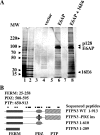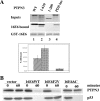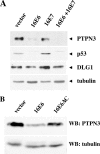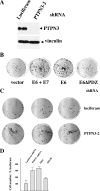Degradation of tyrosine phosphatase PTPN3 (PTPH1) by association with oncogenic human papillomavirus E6 proteins
- PMID: 17166906
- PMCID: PMC1865939
- DOI: 10.1128/JVI.01979-06
Degradation of tyrosine phosphatase PTPN3 (PTPH1) by association with oncogenic human papillomavirus E6 proteins
Abstract
Oncoproteins from DNA tumor viruses associate with critical cellular proteins to regulate cell proliferation, survival, and differentiation. Human papillomavirus (HPV) E6 oncoproteins have been previously shown to associate with a cellular HECT domain ubiquitin ligase termed E6AP (UBE3A). Here we show that the E6-E6AP complex associates with and targets the degradation of the protein tyrosine phosphatase PTPN3 (PTPH1) in vitro and in living cells. PTPN3 is a membrane-associated tyrosine phosphatase with FERM, PDZ, and PTP domains previously implicated in regulating tyrosine phosphorylation of growth factor receptors and p97 VCP (valosin-containing protein, termed Cdc48 in Saccharomyces cerevisiae) and is mutated in a subset of colon cancers. Degradation of PTPN3 by E6 requires E6AP, the proteasome, and an interaction between the carboxy terminus of E6 and the PDZ domain of PTPN3. In transduced keratinocytes, E6 confers reduced growth factor requirements, a function that requires the PDZ ligand of E6 and that can in part be replicated by inhibiting the expression of PTPN3. This report demonstrates the potential of E6 to regulate phosphotyrosine metabolism through the targeted degradation of a tyrosine phosphatase.
Figures







Similar articles
-
Structural and functional characterization of the PDZ domain of the human phosphatase PTPN3 and its interaction with the human papillomavirus E6 oncoprotein.Sci Rep. 2019 May 15;9(1):7438. doi: 10.1038/s41598-019-43932-x. Sci Rep. 2019. PMID: 31092861 Free PMC article.
-
Protein tyrosine phosphatase H1 is a target of the E6 oncoprotein of high-risk genital human papillomaviruses.J Gen Virol. 2007 Nov;88(Pt 11):2956-2965. doi: 10.1099/vir.0.83123-0. J Gen Virol. 2007. PMID: 17947517
-
Structure of the E6/E6AP/p53 complex required for HPV-mediated degradation of p53.Nature. 2016 Jan 28;529(7587):541-5. doi: 10.1038/nature16481. Epub 2016 Jan 20. Nature. 2016. PMID: 26789255 Free PMC article.
-
PDZ Domain-Containing Protein NHERF-2 Is a Novel Target of Human Papillomavirus 16 (HPV-16) and HPV-18.J Virol. 2019 Dec 12;94(1):e00663-19. doi: 10.1128/JVI.00663-19. Print 2019 Dec 12. J Virol. 2019. PMID: 31597772 Free PMC article.
-
Structure and function of the papillomavirus E6 protein and its interacting proteins.Front Biosci. 2008 Jan 1;13:121-34. doi: 10.2741/2664. Front Biosci. 2008. PMID: 17981532 Review.
Cited by
-
Neuronal surface P antigen (NSPA) modulates postsynaptic NMDAR stability through ubiquitination of tyrosine phosphatase PTPMEG.BMC Biol. 2020 Nov 6;18(1):164. doi: 10.1186/s12915-020-00877-2. BMC Biol. 2020. PMID: 33158444 Free PMC article.
-
The Protein Tyrosine Phosphatase H1 PTPH1 Supports Proliferation of Keratinocytes and is a Target of the Human Papillomavirus Type 8 E6 Oncogene.Cells. 2019 Mar 14;8(3):244. doi: 10.3390/cells8030244. Cells. 2019. PMID: 30875834 Free PMC article.
-
A systematic analysis of human papillomavirus (HPV) E6 PDZ substrates identifies MAGI-1 as a major target of HPV type 16 (HPV-16) and HPV-18 whose loss accompanies disruption of tight junctions.J Virol. 2011 Feb;85(4):1757-64. doi: 10.1128/JVI.01756-10. Epub 2010 Dec 1. J Virol. 2011. PMID: 21123374 Free PMC article.
-
Structural and biochemical analysis of the PTPN4 PDZ domain bound to the C-terminal tail of the human papillomavirus E6 oncoprotein.J Microbiol. 2022 Apr;60(4):395-401. doi: 10.1007/s12275-022-1606-1. Epub 2022 Jan 28. J Microbiol. 2022. PMID: 35089587
-
The HPV16 E6 oncoprotein causes prolonged receptor protein tyrosine kinase signaling and enhances internalization of phosphorylated receptor species.PLoS Pathog. 2013 Mar;9(3):e1003237. doi: 10.1371/journal.ppat.1003237. Epub 2013 Mar 14. PLoS Pathog. 2013. PMID: 23516367 Free PMC article.
References
-
- Allen-Hoffmann, B. L., S. J. Schlosser, C. A. Ivarie, C. A. Sattler, L. F. Meisner, and S. L. O'Connor. 2000. Normal growth and differentiation in a spontaneously immortalized near-diploid human keratinocyte cell line, NIKS. J. Investig. Dermatol. 114:444-455. - PubMed
-
- Bohl, J., K. Das, B. Dasgupta, and S. B. Vande Pol. 2000. Competitive binding to a charged leucine motif represses transformation by a papillomavirus E6 oncoprotein. Virology 271:163-170. - PubMed
-
- Brooks, L. A., A. Sullivan, J. O'Nions, A. Bell, B. Dunne, J. A. Tidy, D. J. Evans, P. Osin, K. H. Vousden, B. Gusterson, P. J. Farrell, A. Storey, M. Gasco, T. Sakai, and T. Crook. 2002. E7 proteins from oncogenic human papillomavirus types transactivate p73: role in cervical intraepithelial neoplasia. Br. J. Cancer 86:263-268. - PMC - PubMed
Publication types
MeSH terms
Substances
Grants and funding
LinkOut - more resources
Full Text Sources
Other Literature Sources
Molecular Biology Databases
Miscellaneous

